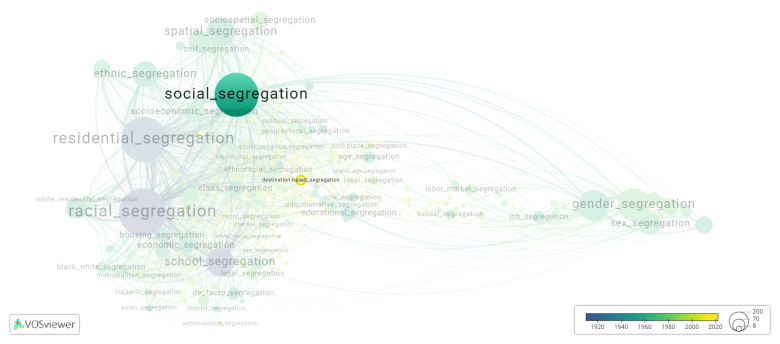Destination-based segregation: Difference between revisions
(Creating page) |
(Creating page) |
||
| Line 22: | Line 22: | ||
[[File:destination-based_segregation.png|780x780px]] | [[File:destination-based_segregation.png|780x780px]] | ||
Visualization based on the [[How_to_cite_Segregation_Wiki| research]] | |||
For the complete network of associated segregation forms, see: | For the complete network of associated segregation forms, see: | ||
year of publication https://tinyurl.com/2235lkhw | * First year of publication https://tinyurl.com/2235lkhw | ||
Louvain clusters https://tinyurl.com/2d8wg5n3 | * Louvain clusters https://tinyurl.com/2d8wg5n3 | ||
* Betweenness centrality https://tinyurl.com/223udk5r | |||
* Disciplines where segregation forms first appeared https://tinyurl.com/244d8unz | |||
==References== | ==References== | ||
==Notes== | ==Notes== | ||
Revision as of 13:40, 3 October 2024
Date and country of first publication[1]
2021
South Korea
Definition
Destination-based segregation refers to a form of segregation where people are separated or segregated based on their intended destination or purpose. This could include different areas or facilities being designated for specific groups of people based on their race, ethnicity, socioeconomic status, or other factors.
For example, destination-based segregation could involve separate neighborhoods or communities being created for different racial or ethnic groups, with certain areas being designated as off-limits to certain groups. This could also involve the segregation of schools, public transportation, or other public spaces based on the intended destination or purpose of individuals.
Destination-based segregation can contribute to social inequalities and perpetuate divisions between different groups of people. It can limit opportunities for interaction and collaboration between individuals from diverse backgrounds, and can reinforce stereotypes and prejudices. Efforts to promote integration and diversity can help to combat destination-based segregation and create more inclusive communities.
Synonyms
The following terms are synonymous with:
destination based segregation.
References and literature addressing this segregation form under these synonymous terms can be found below.
See also
Related segregation forms
Destination-based segregation is frequently discussed in the literature with the following segregation forms:
Visualization based on the research
For the complete network of associated segregation forms, see:
- First year of publication https://tinyurl.com/2235lkhw
- Louvain clusters https://tinyurl.com/2d8wg5n3
- Betweenness centrality https://tinyurl.com/223udk5r
- Disciplines where segregation forms first appeared https://tinyurl.com/244d8unz
References
Notes
- ↑ Date and country of first publication as informed by the Scopus database (December 2023).
At its current state, this definition has been generated by a Large Language Model (LLM) so far without review by an independent researcher or a member of the curating team of segregation experts that keep the Segregation Wiki online. While we strive for accuracy, we cannot guarantee its reliability, completeness and timeliness. Please use this content with caution and verify information as needed. Also, feel free to improve on the definition as you see fit, including the use of references and other informational resources. We value your input in enhancing the quality and accuracy of the definitions of segregation forms collectively offered in the Segregation Wiki ©.
Destination-based segregation appears in the following literature
Abbasi S., Ko J., Min J. (2021). Measuring destination based segregation through mobility patterns: Application of transport card data. Journal of Transport Geography, 92(), -. Elsevier Ltd.https://doi.org/10.1016/j.jtrangeo.2021.103025

